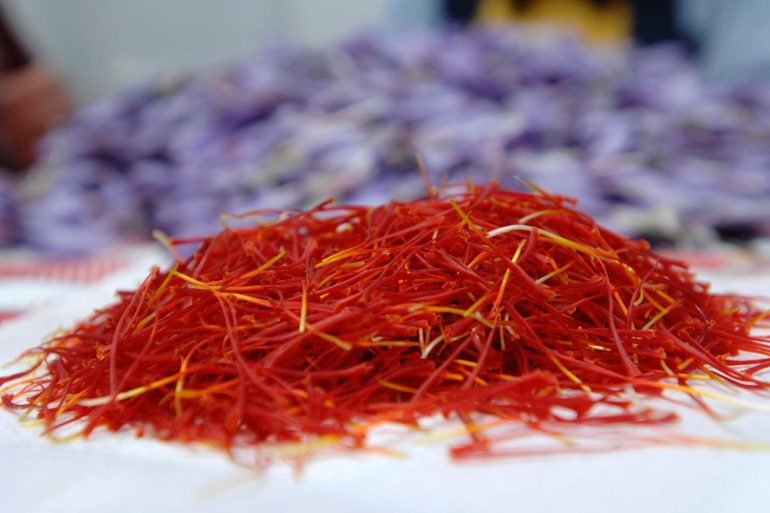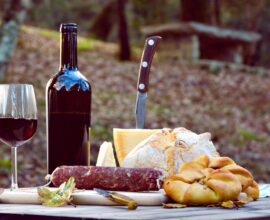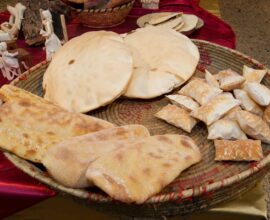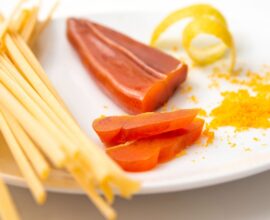Sardinian saffron: the island’s red gold
Sardinian saffron: a fragrant, centuries-old tradition
Saffron is one of the oldest crops in Sardinia, an unmissable ingredient in every dish.
Saffron is numbered among the many prides of Sardinia, the “red gold” has an exotic flavour and vivid colour. It is a product of an ancient tradition that, over the centuries, has successfully established itself in Italy and abroad.
It is a fragrant spice with unmistakable organoleptic properties and has its roots in the Phoenician era. It is believed that the Phoenicians introduced it to the island not as a food aroma but as a powerful dye for fabrics.
With the passing of the centuries and the Punic and Roman domains, saffron was then used as a medicine and textile dye. The first irrefutable document of its commercialisation dates back to the fourteenth century with the “Regulation of the Port of Cagliari” which provided information on the export of saffron stigmas.
Today, thanks to its unique aroma, heady scent and ruby red pistils, Sardinian saffron is one of the territory’s treasures and has been awarded the Designation of Protected Origin (DOP).
To bear this title, Sardinian saffron must have a bright red colour, strong taste and intense aroma, and come from specific areas of the region.
How Sardinian saffron is grown and harvested
Sardinian saffron is unique and is among the most loved and famous spices in the world. Its peculiarity starts from the method of cultivation and harvesting which is governed by precise steps that make it DOP.
The bulbs must be planted by September 15th in loose and well-drained soil. This must not have been cultivated the previous year and at least 4 years must have passed before replanting bulbs in the same soil. Fertilisation can be done only with fertilisers from organic farming.
Producers today are concentrated in the municipalities of San Gavino Monreale (Campidano), Turri and Villanovafranca (Marmilla), the so-called “golden triangle”.
The best time to harvest is the month of November, a rigorous work that begins at the first light of dawn when the flowers are still closed.
After placing them on wicker baskets, the process of “mondatura”, the separation of the stigmas from the flower by hand, is done immediately to avoid damaging the harvest.
Before drying, growers manipulate the stigmas with their fingers moistened with Sardinian extra virgin olive oil, this gives the stigmas a brighter colour and a longer shelf life.
They then proceed to dry the stigmas in the most natural way possible, using mild heat sources to maintain the properties of the saffron.
The secret ingredient of Sardinian cuisine
Sardinian saffron is the precious “secret ingredient” of Sardinian cuisine and is included in various traditional recipes.
Its flavour enriches pasta fillings and desserts, such as Sardinian ravioli, malloreddus, zippulas (typical Carnival sweets), pardulas (sweet or savoury formaggelle prepared during the Easter period) and Sardinian panada (stuffed or rustic pizza).
Furthermore, this red gold can be added to doughs, as in the case of saffron malloreddus and tzippulas or to sauces as in the campidanese sauce, the true condiment for Sardinian gnocchetti.
With its aroma and scent, saffron can elevate any dish and it is an unmissable ingredient in the pantry of those who love the authentic flavours of the island.
To showcase the culinary tradition of Sardinia and the spice that is its pride, the Forte Village Resort in Santa Margherita di Pula in the province of Cagliari, an award-winning resort offering affordable luxury, boasts a wide range of gourmet restaurants that will satisfy all tastes and offer a true sensory experience to every bite.
In the paradisiacal setting of the sunny white beach caressed by the turquoise sea, guests can be surprised by the delicacies of the best Italian and international chefs prepared using only the best raw materials, in a perfect balance between tradition, innovation and experimentation.
Would you like to discover the unmistakable taste of Sardinian saffron and experience a fabulous holiday in an authentic paradise? Discover Forte Village Resort in Sardinia






